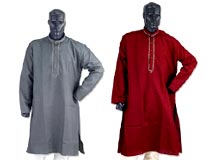 Kurta is a term used to refer to a long loose shirt, the length of which falls below or may be just above the knees of the wearer. In the olden times, it was primarily worn by men, but today, it has become a unisex dress that both men and women can wear. Depending on one's personal preference, kurta can be teamed with churidar as well as loose fit salwar. In the contemporary times, youngsters don kurta along with a funky pair of jeans. To know more about Indian kurta, read on.
Kurta is a term used to refer to a long loose shirt, the length of which falls below or may be just above the knees of the wearer. In the olden times, it was primarily worn by men, but today, it has become a unisex dress that both men and women can wear. Depending on one's personal preference, kurta can be teamed with churidar as well as loose fit salwar. In the contemporary times, youngsters don kurta along with a funky pair of jeans. To know more about Indian kurta, read on.Kurta is a very flexible dress that can be worn on formal as well as informal occasions. You can even wear them at work. Most Indian men prefer wearing kurta pajama during the night. Well, it is due to its extreme comfort that it has become a popular choice amongst the other
nightwear available. Traditional kurta pyjamas have been increasingly gaining momentum amongst the youngsters, who prefer wearing them in their informal social gatherings, with the basic idea of maintaining a distinctive style of their own.
An interesting thing about kurta is that its sleeves do not narrow down (as in the case of most of the sleeves designed in the western style) and fall straight to the wrist. A kurta does not have cuffed sleeves and its side seams are left open for the easy movement of the wearer. The traditional kurtas do not have any collar and their openings are usually centered on the chest. However, the modern kurtas have undergone a major transformation and have stand up collars such as the Nehru collar.
There is an amazing variety of kurtas available at retail outlets, differing in their quality and weaving style. During the summer season, kurtas made up of light silk and cotton are in demand. While for winters, people usually look for heavy fabrics such as wool, Khadi silk or may a handspun. Buttons used in the designing are mostly wooden or plastic. Unlike other pieces of cloth, the buttons are not sewn; rather they are fastened into the cloth as per desire. These days, you can find real beautiful buttons in the market. Some of these buttons are even adorned with jewels and thus are a bit expensive. Thus, kurta is one of the trendiest pieces of clothing in today's times that is well liked by almost all the people.
1 comment:
Thank you so much for sharing..........
Use this keyword for getting more knowledge about Sari click on this hypertext.
Post a Comment